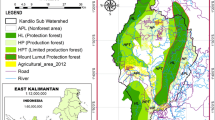Abstract
The major causes of deforestation and degradation of natural resources in the Belete-Gera Forest of Ethiopia are coffee production activities and encroachment into forestland to expand farmland and pasture. Population growth, and the government’s land-reform and re-settlement programs have caused local residents to lose harmony with the land. Forest management in this area hasn’t yet been fully developed. The objectives of this study are to identify the extent of deforestation and natural resource degradation, in preparation for a sound management plan. Encroachment of farmland and pasture into natural forest during the past four years has been identified through interviews and aerial photo interpretation. The encroachment rate is 1.45% per year. Encroachment occurred mostly on areas with gentle slopes adjacent to populated villages and along roads and footpaths. The extent and impact of coffee production activities were examined through agency documents, forest survey data and vegetation survey. It is estimated that up to 49% of the accessible natural forest is under the influence of coffee production activities, among which collecting of naturally grown coffee beans has the least and the coffee plantations has the most impact on the natural forest. Coffee plantations in natural forest have reduced the forest density and species diversity. Age structure of the trees is limited to mature and old classes only, which eventually endangers their function as shade for coffee plantations.
Similar content being viewed by others
Literature cited
Baggio, A.J., Caramori, P.H., Filho, A. Androcioli, and Montoya, L. (1997) Productivity of southern Brazilian coffee plantations shaded by different stockings ofGrevillea robusta. Agrofor. Syst. 37:111–120.
Bekele-Tesemma, A., Birnie, A., and Tengnas, B. (1993) Useful trees and shrubs for Ethiopia. Regional Soil Conservation Unit, Swedish International Development Authority.
Fichtl, R. and Adi, A. (1994) Honeybee flora of Ethiopia. The German Development Service, Addis Ababa.
Kekecha, W. M. (1987) A glossary of Ethiopian plant names, 4th., revised and enlarged. Addis Ababa.
Sader, S.A., Reining, C., Sever, T., and Soza, C. (1997) Human migration and agricultural expansion—a threat to the Maya tropical forests. J. For. 95(12):27–32.
Thirakul, S. (1993) Manual of dendrology for the South, South-east and South-west of Ethiopia. Canadian International Development Agency.
Transitional Government of Ethiopia, Ministry of Natural Resources Development and Environmental Protection (1994) Ethiopian Forestry Action Programme (EFAP) Final Report. EFAP Secretariat, Addis Ababa.
Author information
Authors and Affiliations
Additional information
This project was funded by the Japan International Cooperation Agency.
About this article
Cite this article
Cheng, S., Hiwatashi, Y., Imai, H. et al. Deforestation and degradation of natural resources in Ethiopia: Forest management implications from a case study in the Belete-Gera Forest. J For Res 3, 199–204 (1998). https://doi.org/10.1007/BF02762193
Accepted:
Issue Date:
DOI: https://doi.org/10.1007/BF02762193




